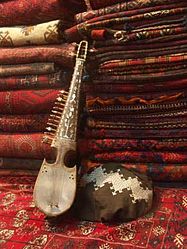Rubab (instrument)
Rubab or Robab (Template:PerB Rūbāb, Hindi: रुबाब) is a lute-like musical instrument from Afghanistan.[1] It is not to be confused with the rebab, which is played with a bow. The rubab is mainly used in the classical music of Afghanistan. A short-necked lute made of wood, with goatskin covering the body, the rubab has three melody strings, three drone strings, and 11 or 12 sympathetic strings. The instrument is made from the trunk of a mulberry tree and the strings are made from the intestines of young goats, brought to the size of thread.
The rubab is attested since the 7th century. It is mentioned in old Persian books, and many Sufi poets mention it in their poems. It is the traditional instrument of Khorasan(Present Afghanistan), and is thus also widely used in countries neighbouring Afghanistan, such as India, Iran, and Pakistan. Rubabs made in India and Iran differ from those of Afghanistan, the Afghanistani rubab (mostly known as Kabuli rubab) is known to be the original. The rubab is known as The Lion of instruments, and is one of the two National Instruments of Afghanistan (together with the Zerbaghali).
It is the ancestor of the North Indian sarod and sarangi[2][3], which are used in Hindustani classical music, but - unlike the sarod - it is a fretted instrument.
Famous players of the rubab are Ustad Mohammad Omar, Mohammad Rahim Khoshnawaz, Homayun Sakhi and Khaled Arman.

The Pamiri rubab (Tajikistan)
In Tajikistan, a similar but distinct [i]rubab is played. This variant generally has a shallower body and neck than the Afghan rubab. The Pamiri rubab has six gut strings, one of which, rather than running from the head to the bridge, is attached partway down the neck, similar to the fifth string of the American banjo.[4]
See also
External links
- World Music Central - Ustad Mohammad Omar LINK
- http://www.amc.org.uk/education/articles/Music%20of%20the%20Uyghurs.htm
References
- ^ David Courtney, Rabab, Chandra & David's Homepage, LINK
- ^ Simon Broughton, Tools of the Trade: Sarod, Published in Songlines-The World Music Magazine, LINK
- ^ Instruments of Afghanistan, afghanland.com, LINK
- ^ Music and Poetry from the Pamir Mountains Musical instruments The Institute of Ismaili Studies.

